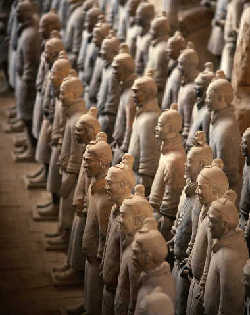The Eighth Wonder of the World

In 1974, Vault 1 of the Terracotta Army of Emperor Qinshihuang was unearthed in Xiyang Village, Lintong County,Shaanxi Province. The terracotta warriors were arranged in a big, orderly arrayed combat formation. No written records of the Terracotta Warriors, considered the Eighth Wonder of the World, have been found.
The terracotta figures were found in a big vault, with a black brick floor, Supported by column frames and covered by timber, reed mats and earth. There are wooden war chariots, clay soldiers and horses in it. The in-situ Vault 1 museum has over 500 clay soldiers, all powerful and life-like to look at. The museum displays less than one-twentieth of the warriors contained in the entire area.
The terracotta warriors present an image of the time when the Qin armies conquered the other rivaling states and united China. The chariots, horses and soldiers were imitations of real ones, and they were arranged to stand in a combat formation. The formation includes three lines in the vanguard, each with 70 soldiers. The soldiers in the vanguard wear short Suits, have their hair in buns and hold bows. Most of them stand facing the east, their bright piercing eyes gazing at something in front of them. Behind them are the main body of soldiers and the war-chariot troops standing in 38 rows. All the soldiers in the main body wear armor and helmets. There are also three lines on the flank facing south, north and west and the rear guards. The arrangement creates an atmosphere of grandeur, making viewers feel as if they, too, are actually on the battlefield. The decorations of the war-chariots and the weapons of the soldiers are all real objects, which adds to the power and strength of the sight.
The figures in the tomb were not cast from a single mould; they were sculptured individually and are, therefore, great artistic treasures. Each looks imposing and is well-proportioned. Although their clothes and hairstyles are similar, their facial expressions are all different. Some are smiling with a look of age and experience; some appear handsome and innocent; others look high spirited while still others seem to be gazing fixedly at something. The expressions and gestures of soldiers are vividly captured in these figures. From the face shape of some of them, we can even guess the region of their birth. The crafting technique of the terracotta warriors is superb. The armor and helmets create a sense of good hard quality, the suits look smooth and soft and their pleats are sharply defined. Even the nails on the suits and the hair and beards of the soldiers are carefully detailed.
The making of the warrior figures combined hand sculpting and moulding techniques. The sculptors used coarse clay as the inner base, covered the base with fine clay, fired the resulting figure in a kiln and then applied color Because of the different aesthetic approaches of the different artists and the varied production techniques, the figures took on great variety of expression and gesture.
